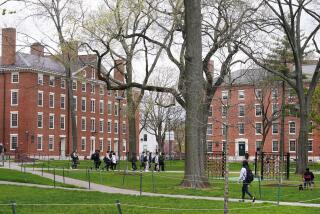SAT Slippage is an Illusion : Education: The good students are still scoring well. A broader base distorts results.
- Share via
Every fall since 1972, the College Board has issued a report showing how the nation’s high school seniors scored on the Scholastic Aptitude Test (SAT). The SAT is a multiple-choice test that measures part of what students are supposed to have learned in high school. It is a moderate predictor of how students will perform in college.
This fall, headlines throughout the country echoed the College Board’s own summary: “SAT Verbal, Math Scores Decline.” The College Board’s data show that the average SAT verbal score has declined from 453 to 422 over the last 20 years, and the average SAT math score has declined from 484 to 474 during the same period.
Are today’s students less able than students of the past? Are the nation’s schools offering a worse education than they used to?
Actually, the decline in SAT scores is more apparent than real and is mainly because of the increased number of students taking the test. In 1972, 25% of 17-year-olds took the test. In 1991, it was 31%.
If I am a teacher and want to maximize the average SAT score of my students, I should select only the best students to take the test. If I encourage a broader group of students to take the test, I am likely to get a few more who will do well, and a lot more who won’t. In other words, as more students take the test, the average score is likely to go down.
It is better to compare the number of individuals who got a good score on the SAT to the total number of individuals in the same age group. This comparison yields different and generally more positive conclusions about what our students know.
On the verbal part of the SAT, about 9% of all 17-year-olds scored 500 or better in 1972. By 1980 only about 6% were scoring 500 or better. However, during the 1980s the percent of high-scoring 17-year-olds has generally increased and is now up to about 8%.
On the math part of the SAT, about 11% of all 17-year-olds scored 500 or better in 1972. The percent of good math scores declined throughout the 1970s, reaching a low of 9% in 1978. Since then, the percent of good math scores has risen sharply, reaching 13% in 1991. This is the highest level in the 20 years that the SAT results have been reported.
Looking at the number of high SAT scores rather than the average SAT score is better because it doesn’t stigmatize our schools or students when more students take the test.
The SAT results don’t indicate anything about the skills of young people who are not college-bound. Indicators like the National Assessment of Educational Progress are needed for that purpose.
In summary, the SAT data suggest that today’s college-bound students are doing somewhat better in math and somewhat worse in verbal skills than they did 20 years ago. These results are neither as good as we would like nor as bad as some would claim.
More to Read
Sign up for Essential California
The most important California stories and recommendations in your inbox every morning.
You may occasionally receive promotional content from the Los Angeles Times.













